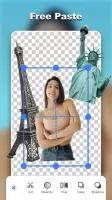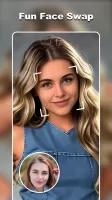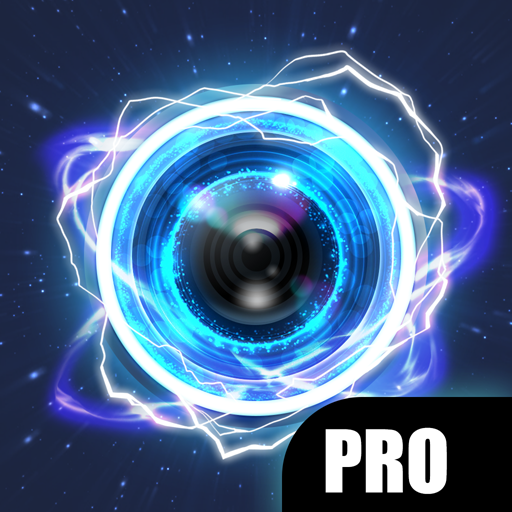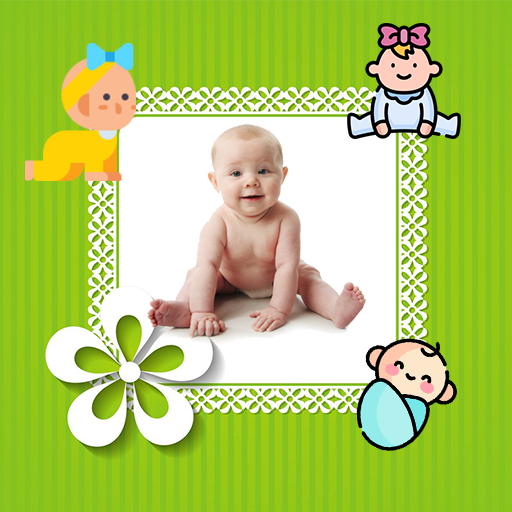Cut and Paste: AI Photo Editor - Edit Photos Easily
Transform your photos with AI magic

- 1.3.9 Version
- 1.6 Score
- 3M+ Downloads
- In-app purchases License
- 12+ Content Rating
🌟 Effortlessly Cut and Paste Photos with This AI-Powered Editing Tool 🌟
In search of a phenomenal app for cutting and pasting objects? Look no further than our revolutionary product: Cut and Paste.
Say farewell to intricate editing software as all you need is two simple steps:
✅ Select what you wish to cut
✅ Place it wherever you desire
Through just a few taps, you can effortlessly cut out and paste images to produce striking photo collages! This tool facilitates the creation of top-notch cutouts, face swaps, background removals, and more!
🎭 Enjoyable Face Swapping 🎭
Ever dreamt of taking cool headshots or trying on a wedding dress in a photo? With just one picture, experiment with various AI Art styles – from sophisticated professional looks 👨💼 to futuristic cyberpunk vibes 🧑🚀, elegant princess aesthetics 🎀 to strong bodybuilder physiques 💪, or even the beautiful glow of pregnancy 🤰 – the possibilities are endless!
✂️ Magical Cutting ✂️
An array of tools is available: lasso, eraser, smoothing, repairing, auto-cut, magic cut... Cut and Paste Photos offers the simplest method to cut out any objects effortlessly!
Eradicate any desired elements, like people👭, trees🌲, or cars🚗, and erase backgrounds within seconds with a mere touch of your fingers.
💯 Seamless Pasting 💯
After cutting comes pasting; now is the time to place your cutouts anywhere you like and blend various elements together to forge amusing photos using your creativity!
Whether it's setting your dog in the sky, moving a traffic light underwater, or swapping faces with celebrities, this potent photo editor seamlessly merges diverse elements.
Feel free to tweak your results by altering colors, adding neon backdrops, flipping cutouts, creating duplicates, or removing imperfections so everything appears flawless.
✈️ Robust Photo Editor ✈️
> Accurate Cut and Paste Functions
> Swift Background Erasure
> High-Caliber Outcomes
> Unleash Endless Creativity
Visualize placing yourself at the red carpet of the Cannes Film Festival or sending your pals to the moon... with our cut-and-paste photo editor, witness your ideas and creativity explode💥!
Don't forget to share 🌐 your masterpieces with the world and prepare to stun your friends!
How AI is transforming the way we edit and enhance photos
In a world where every smartphone comes equipped with a camera, the art of photography has never been more widespread. With a single tap, apps like Facetune smooth out our imperfections, Instagram filters transform the mood of our pictures, and playful tools like the Barbie selfie generator invite us to reimagine ourselves. These everyday use cases are powered by artificial intelligence (AI).
Behind the scenes of whimsical filters and auto-corrected snapshots, AI photo editing technology is changing not just our photos, but the future of photography itself.
“AI tools have grown from simple background remover tools to autopilots that can supplement human creativity across editing, styling, and content generation tasks,” says Matthieu Rouif, co-founder and CEO at Photoroom.
Gone are the days when creating the perfect image required hours of manual tweaking. Today, AI sits at the forefront of this revolution, seamlessly merging with photo editing tools to deliver realistic, high-quality results at the click of a button.
So what exactly is AI in photo editing, and how is it reshaping photography as a medium?
Dive into this article to explore:
- The current landscape of AI in photo editing
- Advancements in AI-powered image enhancement
- Creative applications of AI in photography
- Ethical considerations
- Advantages and limitations of AI in photo editing
- Emerging trends and future predictions
The current landscape of AI in photo editing
Photo editing has come a long way from the basic tools of the early digital era to today's sophisticated AI-powered software capable of transforming a smartphone photo into a high-quality product image for e-commerce or social media in seconds.
“I don’t need Photoshop anymore,” says Nenad Radonjanin, ecommerce manager at Feydom. “I used to do things manually, but now it’s much faster when I can edit many different images at speed. And I can do everything on my phone.”
The journey from simple cropping and color adjustments to the modern-day art of creating visually stunning imagery has been remarkable. A significant contributor to this rapid evolution has been the integration of artificial intelligence into photo editing software.
“The biggest breakthrough of the past few years is certainly image generation models like Photoroom's or Dall-E from OpenAI,” says Eliot Andres, co-founder and CTO at Photoroom. “This has unleashed a new wave of creativity where people can compose images that would have taken months to shoot in real life."
AI's inclusion started as simple automated enhancements but has expanded to more complex edits that previously required extensive manual effort and expertise. With the help of machine learning and neural networks, photo editing software has become smarter, faster, and more intuitive. It can now identify different elements within an image, understand lighting conditions, and even suggest edits to improve an image’s aesthetic appeal.
Good to know: What is an AI photo editor? It's a software tool that uses artificial intelligence algorithms to automatically enhance and manipulate images. These editors can perform tasks such as background removal, object recognition, color correction, image retouching, and more, often with minimal user input. AI photo editors like Photoroom use machine learning and neural networks to analyze and understand images, for more efficient editing processes.
A spotlight on industry pioneers
While Photoroom is a leader in AI photo editing, several other companies are also making significant strides in this domain:
- Adobe. A giant in the creative software world, Adobe continues to harness AI for smarter, more intuitive photo editing experiences.
- Canva. While primarily known as a design tool, Canva integrates AI to enhance image quality and provide smart editing options to its vast user base.
- Clipdrop. A unique platform, Clipdrop uses augmented reality and AI to let users capture and drop real objects into their digital designs.
- FlairAI. Tapping into the power of AI, FlairAI offers intelligent image enhancement, ensuring optimized visuals for different platforms.
- Photoroom. Offering accessible and innovative AI-driven solutions, Photoroom helps creators, brands, and businesses transform ordinary images into professional-quality photos in just a few seconds.
- DALL-E. Using deep learning, DALL-E generates digital images from natural language descriptions, called "prompts".
- RemoveBG. This platform offers swift background removals using AI, simplifying a traditionally tedious task.
- RunwayML. An intersection of creativity and machine learning, RunwayML offers tools and platforms for artists and creators to experiment with AI in their projects.
These companies, alongside Photoroom, are making photo editing both more accessible and transformative, positioning AI not just as an added tool but as a central element in the creative journey.
“Photoroom elevates photography,” says Marcus Aliaga, CEO and creative director at AllTRUEist. “It helps my brand stand out from the vast field of competitors.”
Advancements in AI-powered image enhancement
Advancements in generative AI over the past two years have fast forwarded the photo editing industry by decades. But what AI technologies fuel these developments and how are they applied?
AI technology used in photo editing
"Technologies like deep learning have impacted image editing with smart features like background removal, deblurring, face enhancement, and unwanted object removal, says Eliot. “Before these advancements, editing photos would take hours and hours, with people needing to painfully click all the pixels in an image to select the background or parts of the image. These new algorithms are saving people a lot of time.”
By leveraging advanced AI technologies like machine learning (ML), neural networks, and deep learning (DL), the photo editing industry is experiencing a rapid advancement in image enhancement capabilities.
- Machine learning enables the system to learn from data and improve over time, making photo editing tools more efficient and user-friendly.
- Neural networks mimic human brain functionality, empowering software to recognize patterns and make decisions, facilitating a better understanding of images.
- Deep learning, a subset of ML, further pushes the envelope by enabling the processing of large datasets to improve the accuracy and effectiveness of photo editing tools.
“In the past, you would start from an existing image and then you would remove some parts or you would change it a bit, but there was nothing that the machine learning model would invent or generate out of the blue,” says Ben Lefaudeux, head of machine learning at Photoroom.
“But with generative AI, something that’s become more popular in the past year or two, you can actually remove parts of an image and you can task a model with coming up with a new image or illustration when there's no link to what was there before. You start from almost nothing and it has to come up with something new.”
AI’s role in automating photo edits
The application of AI in photo editing is not just enhancing the quality of images, but also democratizing photo editing, making it accessible to a broader spectrum of users. It’s transforming manual tasks into automated processes, simplifying the entire editing procedure.
"At Photoroom we value creativity more than anyone, says Matthieu. “Our goal is to make creating unique studio-quality visuals accessible to any business worldwide.”
Let’s look at a few ways AI is used to enhance images:
Noise reduction
Noise, the unwanted grain or speckles in photographs, often results from low light conditions or higher ISO settings. AI-powered noise reduction tools can meticulously analyze the noise patterns and remove them while retaining the essential details of the image. Companies like Topaz Labs have developed noise reduction software that leverages AI to maintain image clarity even in challenging conditions.
Automatic color correction
Achieving the right color balance can be a painstaking process. However AI photo editing tools can automatically analyze an image and adjust the colors to achieve a more natural or desired look. Adobe's Sensei AI, for example, offers auto color correction, making it a breeze for users to attain the right mood and tone for their images.
Object removal
Removing unwanted objects used to be a time-consuming task requiring a high level of expertise. AI has simplified this with tools that can intelligently identify and remove objects with a level of precision that drastically reduces the time and effort required. Photoroom’s Retouch tool lets users remove unwanted objects or people from photos by painting over them with their fingers, making it faster and easier to achieve a cleaner composition.
“I'm still blown away by object removal,” says Andres. “Every time I use it in Photoroom, it feels like I have a magician in front of me performing. The object is there, but one second later, it disappears from the image! And the pixels replacing it match the image, even for complex patterns or environments."
Style transfer
Style transfer is a feature where AI assists in applying the artistic style of one image to another. Apps like Prisma have popularized this concept, helping users transform ordinary photos into appealing artwork reminiscent of iconic painting styles. This blend of AI and creativity opens up an avenue for exploration and experimentation that was not possible before.
Removing and replacing backgrounds
 Before AI in photo editing, removing and replacing backgrounds was time-consuming and required Photoshop skills to execute. But with tools like Photoroom’s Background Remover and AI Backgrounds, brands, makers, and photographers can easily remove backgrounds and then choose from a range of existing templates or enter manual AI prompts to create AI-generated background options.
Before AI in photo editing, removing and replacing backgrounds was time-consuming and required Photoshop skills to execute. But with tools like Photoroom’s Background Remover and AI Backgrounds, brands, makers, and photographers can easily remove backgrounds and then choose from a range of existing templates or enter manual AI prompts to create AI-generated background options.
Shadows and lighting
 Images with flat, solid backgrounds give no depth to the photo. In the past, high-quality product images with the right lighting and shadows required renting a studio and lighting, hiring a photographer, and waiting weeks for the retouched images. Nowadays, AI photo editing tools like Photoroom’s AI Shadows help users add studio-quality (volume aware) shadows to images in seconds, creating realistic, eye-catching, and clean product photos.
Images with flat, solid backgrounds give no depth to the photo. In the past, high-quality product images with the right lighting and shadows required renting a studio and lighting, hiring a photographer, and waiting weeks for the retouched images. Nowadays, AI photo editing tools like Photoroom’s AI Shadows help users add studio-quality (volume aware) shadows to images in seconds, creating realistic, eye-catching, and clean product photos.
Creative applications of AI in photography
AI in photography is not just reshaping individual creative processes but is transforming the industry as a whole. Its influence is vast and varied, touching everyone from seasoned professionals to budding enthusiasts and large brands.
“Photoroom helps me with my six figure online business and also helped me launch my social media platforms,” says Amazon seller, Owen Lloyd. “Sales were absolutely awful before Photoroom. On a good day, I’d sell three bottles of perfume. Now, a normal day is at least 50 bottles, that’s around 16 times more sales than before. Photoroom can take credit for my increase in sales.”
Let’s look at how AI photo editing is applied to various sectors:
Professional photographers
For seasoned photographers, AI is a game-changer, saving lots of time and introducing cutting-edge enhancements that elevate their portfolio.
SMEs and creators
For small to medium enterprises and individual creators, AI-driven tools bridge the gap between limited resources and high-quality outputs. SMEs can deliver sophisticated edits without the need for large teams or extensive training. See here a list of the 16 best Ai tools.
“Photoroom is by far better than all the other AI tools that are on the market,” says content creator, Mike Jay. “I’m happy to pay for the Pro version—an edit takes you three to five seconds, saving you lots of time over the course of weeks and months, it’s worth paying for.”
Ecommerce
High-quality images drive online sales, and AI aids in achieving this. From auto background removals to enhancing product image quality and lighting, AI ensures that product listings are visually compelling, directly influencing consumer buying decisions.
“We are a family owned business,” says Andrew Cattarin, ecommerce manager at The Gamesmen. “Photoroom allows us to do more with our small team and scale. With AI tools coming into play, it helps our niche—we don’t have money to burn or to hire tons of staff to get work done. We have 15,000 products to list online which would normally be a monstrous manual task that takes weeks and weeks.”
Elevate your photo game with our AI photo editing tools —a seamless blend of innovation and ease. Try it out for flawless results!
Integrated AI photo editing for brands
Large brands across sectors like film and entertainment, food delivery, and marketplaces can use an AI photo editing API like Photoroom’s to complete photo edits natively in an existing website or app. This eliminates the need for a third-party platform to execute image enhancements, streamlining workflows and enabling creativity at scale.

"Photoroom, the groundbreaking technology powering BarbieSelfie.ai, shattered all expectations by seamlessly integrating user photos into captivating Barbie movie posters,” says Cameron Curtis, EVP of worldwide digital marketing at Warner Bros. “Photoroom's unparalleled ease of use became the catalyst for a viral sensation, propelling the Barbie Selfie Generator into the digital spotlight and captivating audiences worldwide.”
Hobbyists and makers
For those who pursue photography or selling handmade products as a passion, AI tools democratize access to advanced editing. No longer is state-of-the-art photo enhancement exclusive to professionals; even a beginner can craft masterpieces with AI's assistance.
“I’m not very good at doing online stuff, but I know it’s imperative to showcase my jewelry well,” says Louise Brill, jewelry designer at Silverwaters. “I’m not a professional photographer, and I find other apps confusing. Photoroom is user friendly—within one minute, I can create five different images, and they’re all good. Now, when I am making jewelry I’m more excited about the photography process.”
Ethical considerations
In a world increasingly dominated by AI, it's not just about what the technology can do, but also how it's used. Ensuring ethical practices in AI photo editing is crucial for companies and society at large.
Let’s look at some of the ethical concerns and how companies can address them:
Manipulation and misinformation: the rise of deepfakes
One of the most alarming by-products of advanced AI in photo editing is deepfakes. These are hyper-realistic but entirely fake content, created by AI algorithms. While the technology showcases the effectiveness of AI, it simultaneously poses threats. False imagery can lead to misinformation, tarnishing reputations, and misleading the public.
“Literature has facts and fictions as two pillars, and it’s likely that visual content creation will have the same in a post-GenAI world,” says Ben. “The facts pillar (factual image capture from a camera) is already being worked on by camera manufacturers, there’s a clear path here.”
Theft and plagiarism
AI can seamlessly replicate styles and recreate images, blurring the lines between inspiration and imitation, something that leads to concerns about theft and plagiarism. As advancements in AI photo editing tools continue, there's a growing risk that original works could be duplicated or slightly altered. Creators risk losing recognition and the value of unique, authentic work could deteriorate. For photographers, creators, and businesses alike, this presents two challenges: protecting their work in an increasingly digital landscape while also navigating the ethical considerations of how and when to use AI in their creative processes.
“At Photoroom, we avoid this by design,” says Ben. “For AI Backgrounds, we keep the original user content as the centerpiece of the final AI-assisted creation, it's original and real-world grounded by default.”
Privacy concerns in an AI-driven world
With AI's capability to analyze and recognize faces, privacy issues come to the forefront. AI algorithms, if misused, can be employed for unauthorized surveillance, data mining, or even stalking. It raises critical questions about consent and the boundaries that need to be set for AI's reach.
Human bias in AI algorithms
AI, though machine-driven, isn't free from human influence. If the data it's trained on carries biases, the AI will too. This can manifest in photo editing in the form of favoring certain skin tones, facial structures, or even backgrounds over others, leading to a skewed and biased representation.
“A starting point will always be biased, the question is only by how much. Anybody claiming that they have something unbiased is just not aware of it yet,” says Ben. “What we're building at Photoroom, is a (machine learning backed) way to handle user and expert feedback. People will soon be able to report visual examples of content that we don't generate well, and we'll update our training set in a meaningful way. Human feedback is too small scale, that’s why we're crafting a bridge in between this and the volume that machines need to learn.”
Steps companies can take to uphold ethics
Addressing these concerns is imperative for companies in the AI photo editing sector. Here are some ways to ensure ethical practices:
- Transparency. Clearly label AI-edited content, ensuring consumers can distinguish between human-made and AI-altered visuals.
- Privacy protocols. Incorporate stringent data protection measures. Ensure that user data isn't exploited or misused, and always seek explicit consent before any data processing.
- Bias audits. Regularly audit and refine AI algorithms. Source diverse training datasets to avoid inherent biases and ensure fair representation in outputs.
- Open dialogue. Foster an environment where ethical concerns can be discussed openly. Engage with the community, understand their worries, and iterate based on feedback.
Advantages and limitations of AI in photo editing
The integration of AI in photo editing brings a mix of notable benefits and potential drawbacks.
Advantages
Enhancing creative possibilities and processes
AI is more than just a tool; it's an active collaborator in the creative process. Features like style transfer infuse photos with iconic artistic styles, while color grading, intelligent object detection, and auto-composition tools let creators explore new avenues. Automating mundane tasks and introducing intelligent enhancements provide space to experiment and innovate in ways that were previously either time-consuming or impossible. It also leaves time to focus on the larger creative vision.
"People used to spend 90% of their time on repetitive tasks like clicking to select the contour of an object and 10% on creative tasks,” says Andres. “With the advancements in AI photo editing technology, they're free to spend much more time on creative workflows and are no longer blocked by complex edits.”
Speeding up complex editing
A prime example of AI's efficiency is the ability to remove and replace backgrounds or unwanted objects in seconds. What once required meticulous attention to detail, layer adjustments, and potentially hours of work can now be executed in seconds with the right AI photo editing tools.
Tools like Adobe's Sensei and Photoroom use AI to identify and differentiate backgrounds and objects from other elements, making replacements seamless and efficient.
“There’s a much shorter bridge in between the intent; the creativity or picture you have in mind, and the result,” says Ben. “Before, there was a significant expertise barrier, but with generative AI, it’s much simpler. You can explain what you want using another image as an example or you can write prompts. ML models can learn over time and make suggestions in a shorter amount of time, making the process more fluid, and opening up the feature to a lot more people.”
Democratizing photo editing
“People used to think, ‘Wow, this Nike ad in a magazine looks amazing; I wish I could do that for the hand-crafted shoes I sell’,” says Eliot. "Now, they can reach this level of quality with very little time and effort and proudly showcase their products."
With AI photo editing, you don't need to be a seasoned professional to craft stunning images. AI-based platforms simplify complex tasks, making high-quality photo editing accessible to all.
“Photoroom is taking AI photo-editing technology to a new level, opening up new creative opportunities to everyone, not just experts or people with huge budgets,” says Matthieu.
Limitations
Over-reliance
A heavy dependence on AI could lead to stagnation in human skills. Editors might find themselves out of touch with manual editing techniques that form the core of many artistic processes.
Loss of human touch
While AI can mimic and sometimes even surpass human capabilities, it lacks the intrinsic human touch, intuition, and emotional connection that often drives truly memorable creative outputs.
Consistency vs. authenticity
AI models, when applied broadly, can lead to a certain uniformity in edited images. The risk is that photos across different platforms or even from different photographers might start to look eerily similar, potentially diluting unique styles and diminishing the authenticity of an artist's personal touch.
“Our ‘Image Guidance’ way of getting some help from AI is great since there's a natural way for users to inject their creativity, but it may not be enough,” says Ben. “AI models are great mixers, but real originality is still a human strong point.”
Striking a harmonious balance
The answer isn't to avoid AI but to integrate it mindfully into the creative process. Here's how a balanced approach might look:
Blend tools. Use AI for repetitive tasks and heavy lifting, but don't shy away from manually adjusting details where nuanced human judgment is essential.
Continuous learning. Professionals should keep honing their skills. Engage in workshops, training, and hands-on projects to ensure a holistic skill set that isn't solely reliant on AI.
Feedback loops. AI can learn from us, and we can learn from AI. Establish feedback loops where AI provides suggestions, and humans make the final judgment. Over time, this collaborative approach can lead to more refined AI tools that resonate with human sensibilities.
Emerging trends and future predictions
Let's peek into the future of AI in photo editing.
Anticipating the next wave of advancements
The world of AI in photo editing is ever-evolving, with technological leaps often occurring at a rapid pace. As we look into the future, we can anticipate more sophisticated algorithms, even more intuitive user interfaces, and advancements that further blur the lines between human and machine capabilities in photo editing.
"I'd recommend following generative artists on Twitter, Reddit, or YouTube,” says Eliot. “These artists are at the forefront of what's possible with technology, pushing the limits. For instance, Thibaud Zamora just released a movie entirely created with AI. You can also subscribe to Photoroom's newsletter. We're always showcasing upcoming features."
Sign up now to start receiving PhotoRoom’s newsletter! And test some of our free AI photo editing tools while you’re at it.
AI tools of the future: Beyond just editing
While current tools focus largely on refining existing images, future AI applications might offer more predictive features. Imagine tools that suggest optimal photography angles, lighting conditions, or even composition strategies before a shot is taken. Additionally, AI-driven platforms (like DALL-E) that can craft images from mere textual descriptions will improve or generate entirely new visuals based on mood or emotion inputs.
Beyond this, the integration of AI with augmented reality (AR) and virtual reality (VR) in photo editing could redefine immersive experiences. Editing tools could allow for real-time modifications in AR/VR spaces, providing unprecedented avenues for creators in fields like gaming, film, and interactive media.
“Generative AI in photo editing is not a fad”, says Ben. “I think it will stay for a while. It’s a great tool that complements existing editing methods. And it solves the problem of slow and cumbersome photo editing processes.”
New entrants shaping the future landscape
With the immense potential of AI in photo editing, it's only natural to expect new players to venture into this domain. Tech giants, traditionally not associated with photography, might diversify and introduce AI-based editing tools (something Photoroom is prepared to help with). Additionally, startups with innovative solutions might challenge established players, pushing the envelope of what's possible and setting new industry standards.
Embrace AI in photo editing
AI is truly changing the game in photo editing, opening doors to new possibilities and ideas. As we progress, it's essential to keep an open mind, embrace innovations, and be prepared for a future where AI is not just an assistant but an innate part of the creative journey. Dive in, embrace these evolving tools, and discover the magic AI brings, especially with platforms like Photoroom leading the way.
- Version1.3.9
- UpdateAug 31, 2024
- DeveloperDaily Joy Studio
- CategoryPhotography
- Requires AndroidAndroid 6+
- Downloads3M+
- Package Namephotoeditor.backgrounderaser.cutandpastephotos
- Signatureb6c183022e08fdf4f5f6e3ca40566816
- Available on
- ReportFlag as inappropriate
-
NameSizeDownload
-
13.84 MB
-
33.95 MB
-
33.99 MB























magic selection did very well
easier and better to use
better if you could zoom
price is outrageous
Blurs images